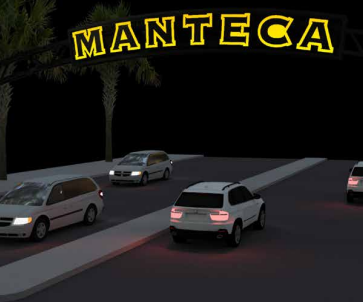Union Pacific is working on an expansion of their intermodal facility sandwiched between the cities of Lathrop and Manteca that will ultimately allow the railroad to handle 730,000 “lifts” a year.
Lifts refer to the transfer of shipping containers by use of an overhead crane from truck trailers to railroad flatcars.
The South San Joaquin Irrigation District board on Tuesday is being asked to sign off on plans that will allow the work to take place during the upcoming irrigation season.
The expansion onto 142 acres to the east of the railroad main line will create somewhat of a mirror of existing operations on the west side of those tracks.
It will bring the developed intermodal yard all the way to the western edge of Intermodal Way that connects with Roth Road behind 5.11 Tactical, Amazon, and the Penske Logistics operation that serves Lowe’s Home Improvement stores.
The expansion of the intermodal yard is designed to serve Union Pacific customers in the greater San Francisco Metroplex of 18 million consumers.
It is located in what is now the heart of one of the nation’s largest distribution and logistics centers — South San Joaquin County — and is equal distance to major markets such as San Jose, Sacramento, and San Francisco.
As such, Union Pacific in 2019 advised Manteca city leaders to expect up to 135 trains eventually to pass through the city each day.
That’s an enormous leap from today’s railroad traffic that now sends upwards of 56 trains each day through the middle of Manteca along the UP main line that stops vehicle movements at nine at-grade street crossings.
The additional 56 freight trains are on top of ACE commuter trains that will start running later this year or early 2025 from Ceres to either San Jose or Sacramento with a stop in downtown Manteca.
Those trains are also likely to be longer as well in terms of the number of flatcars, boxcars, tankers, and hoppers being pulled.
Trains blocking crossings are already a major daily irritant for Manteca motorists. That is especially true at the Industrial Park Drive/Spreckels Avenue as well as Woodward Avenue crossings where trains use a siding to temporarily park to allow other trains to pass blocking the crossing for upwards of 20 minutes at a time.
Twenty years ago, those crossings saw very little traffic as no development had occurred south of the 120 Bypass.
It can be almost as bad when a slow, long train passes through the Yosemite Avenue and Center Street crossings in downtown during heavy vehicle traffic periods during the week on and even Saturdays. It is not unusual for long backup of traffic on Yosemite Avenue and Main Street that can lead to blocking intersections even at Center Street effectively paralyzing much of the traffic movement in the central district.
It is rare in California for a city of Manteca’s size on a major rail corridor to have multiple at-grade crossings where trains typically travel at 55 mph or more.
There is no other city on the UP Fresno line that carries freight through the San Joaquin Valley and into Southern California that has that many trains passing through at high speeds. There are also five at-grade crossings on the UP line that runs along the western border of Manteca and heads over the Altamont and into the Bay Area.
Besides trains blocking crossings, an additional 79 trains passing through Manteca every 24 hours is likely to be problematic for fire and police responses.
When work is finished on the first phase of the 120 Bypass/Highway interchange upgrade project, the Austin Road replacement bridge will also clear the tracks. A road connecting Austin to Atherton Drive will also be built allowing vehicles to reach areas in south Manteca as well as travel to Moffat via a new alignment of Woodward Avenue across the tracks in order to reach the central part of the city.
When UP’s intermodal expansion is done, the regional capacity for intermodal movements will soar to 1.3 million units a year between the UP complex and the Santa Fe intermodal facility north off Manteca between Austin Road and Jack Tone Road. That is the equivalent of 3,561 truck movements a day.
The 2001 expansion of the Santa Fe facility increased that railroad’s intermodal capacity in San Joaquin County from 120,000 to 300,000 units annually.
Currently the UP intermodal facility can “lift” — remove and place truck trailers on specially designed railroad flat cars — on some 270,000 container a year. At build-out that number will reach 730,000 lifts.
UP spokesmen have pointed out that the facility expansion ultimately will reduce truck traffic on major freeways as one freight train moving trailer containers does the work of 280 long-distance trucks.
Trucks, however will need to pass through parts of Lathrop or Manteca to deliver trailers to the intermodal facility as well as to pick them up and take them to their final destiny.
To contact Dennis Wyatt, email dwyatt@mantecabulletin.com






